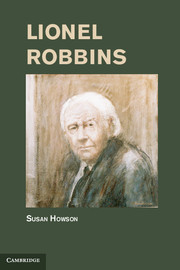Book contents
- Frontmatter
- Contents
- Illustrations
- Abbreviations
- Introduction
- One Father and Son
- Two The Great War
- Three Postwar
- Four The London School of Economics
- Five Iris Gardiner
- Six New College Oxford
- Seven The Young Professor
- Eight Fritz and Lionel
- Nine The School in the Mid-1930s
- Ten The Approach of War
- Eleven The Economics of War
- Twelve Director of the Economic Section
- Thirteen Anglo-American Conversations
- Fourteen The Law Mission and the Steering Committee
- Fifteen 1 9 4 4
- Sixteen The Last Months of the War
- Seventeen The Postwar Settlement
- Eighteen Return to the School
- Nineteen The End of the Transition
- Twenty LSE in the Early 1950s
- Twenty-One Chairman of the National Gallery
- Twenty-two Lord Robbins
- Twenty-three The Robbins Report
- Twenty-four The Sixties
- Twenty-five The Arts
- Twenty-six The Troubles at LSE
- Twenty-seven Retirement
- Conclusion
- Bibliography
- Index
Four - The London School of Economics
Published online by Cambridge University Press: 07 October 2011
- Frontmatter
- Contents
- Illustrations
- Abbreviations
- Introduction
- One Father and Son
- Two The Great War
- Three Postwar
- Four The London School of Economics
- Five Iris Gardiner
- Six New College Oxford
- Seven The Young Professor
- Eight Fritz and Lionel
- Nine The School in the Mid-1930s
- Ten The Approach of War
- Eleven The Economics of War
- Twelve Director of the Economic Section
- Thirteen Anglo-American Conversations
- Fourteen The Law Mission and the Steering Committee
- Fifteen 1 9 4 4
- Sixteen The Last Months of the War
- Seventeen The Postwar Settlement
- Eighteen Return to the School
- Nineteen The End of the Transition
- Twenty LSE in the Early 1950s
- Twenty-One Chairman of the National Gallery
- Twenty-two Lord Robbins
- Twenty-three The Robbins Report
- Twenty-four The Sixties
- Twenty-five The Arts
- Twenty-six The Troubles at LSE
- Twenty-seven Retirement
- Conclusion
- Bibliography
- Index
Summary
When Lionel Robbins entered the London School of Economics in October 1920, this Fabian institution was twenty-five years old. On 3 August 1894 Sidney Webb learned that he was an executor and trustee of the estate of the late Henry Hunt Hutchinson whose will instructed him to spend most of the estate on ‘the propaganda and other purposes’ of the Fabian Society and ‘to advancing its objects in any way they [the executors] deem advisable’. Over breakfast the next day Webb persuaded his wife Beatrice and his friends Graham Wallas and George Bernard Shaw that they could spend some of the money on founding a school of economics. Within a few months he had a director, W.A.S. Hewins, who was not a socialist or a Fabian, Wallas having declined the position, and on 10 October 1895 classes and lectures began (Dahrendorf 1995, 1–24). A year later the School had a library, the British Library of Political and Economic Science. It became a college of the University of London in 1900, moving to its present location, Clare Market, just off Aldwych, in 1902 (Hayek 1946, 9–14). With that history it is inevitable that LSE should be regarded as a left-wing institution, even when most of its staff, like the first director, were not. In 1920 it was physically still very small – construction of the main building in Houghton Street, now long since known as the ‘Old Building’, had just begun – and many lectures had to be given in temporary buildings to cope with the postwar influx of students, many of them like Robbins ex-servicemen. The students were not in the mood to complain: ‘Ex-soldiers, as the majority of us were, we thought we were lucky to be alive and where we were’ (Robbins 1971a, 72).
It was in 1919 and 1920 that ‘a number of those arrived at LSE who were to determine more than others the character and appearance of the School for decades to come’, including Robbins and Arnold Plant (Dahrendorf 1995, 144). Plant had served as a private in the Royal West Kent Regiment in 1918; after demobilization in January 1919 he had been general manager of the engineering works at the Steam Fittings Co. The historian of the School also singles out Sydney Caine, who like Plant became a close friend of Robbins in their undergraduate years; Caine was younger than Robbins and Plant, too young to have served in the forces, but entered a year earlier, as did Frederic Benham (London School of Economics 1934). Robbins’s fellow students included his existing LSE acquaintances Jacques Kahane (a year ahead of him) and Basil Bunting.
- Type
- Chapter
- Information
- Lionel Robbins , pp. 68 - 102Publisher: Cambridge University PressPrint publication year: 2011

